Forums
- Forums
- Duggy's Reference Hangar
- USAAF / USN Library
- Vought XF8U-3 Crusader III
Vought XF8U-3 Crusader III
Post a reply
- Go to Previous topic
- Go to Next topic
- Go to Welcome
- Go to Introduce Yourself
- Go to General Discussion
- Go to Screenshots, Images and Videos
- Go to Off topic
- Go to Works in Progress
- Go to Skinning Tips / Tutorials
- Go to Skin Requests
- Go to IJAAF Library
- Go to Luftwaffe Library
- Go to RAF Library
- Go to USAAF / USN Library
- Go to Misc Library
- Go to The Ops Room
- Go to Made in Germany
- Go to Campaigns and Missions
- Go to Works in Progress
- Go to Juri's Air-Raid Shelter
- Go to Campaigns and Missions
- Go to Works in Progress
- Go to Skinpacks
- Go to External Projects Discussion
- Go to Books & Resources
-
4 years agoSun Sep 11 2022, 01:27pmDuggy
 Main AdminIn 1956, with production of the F8U Crusader well under way, Russ Clark and his team at Vought were already beginning to think about its successor. The XF8U-3 Crusader III was the result.
Main AdminIn 1956, with production of the F8U Crusader well under way, Russ Clark and his team at Vought were already beginning to think about its successor. The XF8U-3 Crusader III was the result.
The Vought XF8U-3 Crusader III (known by the company as the Vought V-401) was an extremely advanced fighter interceptor of the late 1950s. Although the aircraft was designated XF8U-3, it was essentially a completely new design and bore only a superficial relationship to the earlier F8U-1 and F8U-2.
Vought decided not to call their entry the XF9U-1, which would have been the logical choice. Instead, they designated the aircraft XF8U-3 Crusader III. Why Crusader III? The F8U-2 (F-8C) was considered such a major upgrade that it was initially called Crusader II, so it was logical to call the XF8U-3 Crusader III.
Five prototypes were ordered, serial numbers being 146340, 146341, and 147085/147087.
The XF8U-3 had the same general configuration as that of the earlier Crusader, and kept the variable-incidence wing. However, the XF8U-3 was appreciably larger and more powerful. The fuselage was enlarged to accommodate a Pratt Whitney J75 turbojet, with a thrust almost 60 percent greater than the J57 of the F8U-1 and -2. The lower lip of the chin-mounted intake was raked forward in order to achieve Mach 2+ performance. The intake was of fixed geometry, with no mechanically-complex moving parts. A large spill door for intake duct pressure balance was provided on each side of the fuselage just underneath the wing leading edge. The vertical tail was appreciably broader, and an afterburner cooling intake duct was mounted in a forward extension of the vertical fin. Perhaps the most distinctive feature was the use of a pair of large ventral fins which were extended vertically downward when the aircraft was in flight. These fins were retracted to a horizontal position for landings and takeoffs.
The one-piece variable-incidence wing was similar to that of the existing Crusader, but had a greater span and a greater area. It was hinged at the rear spar, and the variable incidence was accomplished by means of a pair of hydraulic jacks. The wing folded at the 64 percent semi-span line, at which point there was a pronounced notch or dog-tooth. The entire leading edge was fitted with a double-drooped flap and the training edge was made up of flaps and flaperons between the fuselage and the fold line. Both flaps and flaperons had boundary- layer control "blowing", in which high pressure air bled from the engine compressor was exhausted over the upper surfaces. There was a pair of spoilers which provided roll control when the flaperons were automatically disengaged at speeds above a pre-determined limit.
Weapons control was to be handled by the Raytheon Aero 1B system, which incorporated an AN/APA-128 radar set and Autotechnicas AN/AWG-7 missile control system with AN/APA-138 cockpit displays. The radar was the Westinghouse AN/APG-74. This combination was tested on the third aircraft (147085) before the termination of the program. Production aircraft were to have been equipped with an AN/APQ-50 radar which would have required some changes in the nose radome to accommodate its larger dish.
The Crusader III was to be be armed with three Sparrow missiles mounted semi-recessed inside slots cut into the lower fuselage. There was one slot on each side of the lower fuselage (located just ahead of the main landing gear doors), and one slot was cut into the port side of the belly. The nose wheel was slightly offset to starboard to give clearance to the belly-mounted Sparrow. Had the Crusader III ever reached production, a pair of shorter-range AIM-9 Sidewinder would also have beam mounted on pylons on each side of the fuselage, in much the same fashion as was installed on later versions of the F-8. In a concession to tradition, the usual quartet of 20-mm cannon was to be fitted, even though the conventional wisdom of the time was that the air-to-air missile would make kills possible at such long ranges that cannon armament would never be used in combat. No cannon armament was actually ever installed.
On July 25, 1955, the Navy authorized the construction of two XF8U-3 prototypes. Three more prototypes were ordered later.
The XF8U-3 found itself in competition against the F4H Phantom II. In the spring of 1958, the Navy established two preliminary evaluation teams, one dedicated to the Phantom II and the other to the Crusader III.
The first prototype took off on its maiden flight on June 2, 1958, test pilot John Konrad at the controls. This was six days after the first flight of the rival McDonnell Phantom. The aircraft was flown with three dummy Sparrow missiles mounted in slots cut into the fuselage, one on each side and one on the fuselage belly. The second prototype took to the air on September 27, 1958.
During flight testing, the XF8U-3 demonstrated speeds of Mach 2.2 and zoom climb altitude of nearly 90,000 feet. Sustained altitude levels of 60-65,000 feet could be achieved. The Crusader III was never flown to its limits because of the windshield construction, which was made of acrylic and could not take the high temperatures of the aircraft's upper envelope. It was thought that without the windshield limitations it could have reached speeds as high as Mach 2.7 or 2.9 at 35,000 feet.
The flight test program went exceedingly well, and the XF8U-3 showed great potential. However, there were problems with intake duct "rumble" which depended on the rate of acceleration, altitude, and attitude. As the plane accelerated, the rumble would start at about Mach 1.35. It initially appeared somewhere behind and underneath the pilot and move forward in the duct as the plane moved faster. Eventually, the duct would suddenly "unload" with a explosive sound, which was very unnerving to the pilot. The duct criticality was designed out of the airplane after the initial phase of the tests.
Although the Crusader III showed great promise, the Navy chose the competing McDonnell Phantom as the winner of the contest. The XF8U-3 was designed exclusively as a fighter/interceptor, but the Phantom was designed to a more encompassing set of requirements which included interception, reconnaissance, and ground attack roles.. The Vought development contract was cancelled in December of 1958. The limiting windshield was being redesigned when the contract was cancelled. At the time of cancellation, three XF8U-3s had been built and flown, and a further six were in various stages of construction. Serials had been allocated for a further 13 pre-production examples (BuNo 147088/147100)
Had it been accepted for production, the XF8U-3 aircraft would have been the world's fastest jet aircraft in service, with a maximum speed perhaps approaching Mach 3. It had excellent acceleration, maneuverability and high-speed stability. It was a delightful airplane to fly, with excellent control harmony. The aircraft was in every way a winner, and it is a pity that no place in the Navy could be found for it.
Following the cancellation of the program, all three XF8U-3 prototypes were turned over to NASA, along with the almost-completed fourth air frame as a source of spare parts. 146340 became NASA 226, 146341 became NASA 227. These were used for supersonic boom measurements at NASA Langley, VA, in a series of supersonic runs between Wallops Island, Virginia and Virginia Beach, VA at speeds of up to Mach 2.2. BuNo 147085 was turned over to NASA/Ames in June of 1959, becoming NASA 225. It was used at NASA Ames and Edwards AFB for flight systems work and for autopilot development.
The two Langley-based XF8U-3s were scrapped in early 1960. The Ames/Edwards plane appears also to have been scrapped. The spares air frame seems to have ended its life in fire-fighting drills. Consequently, no XF8U-3s survive today.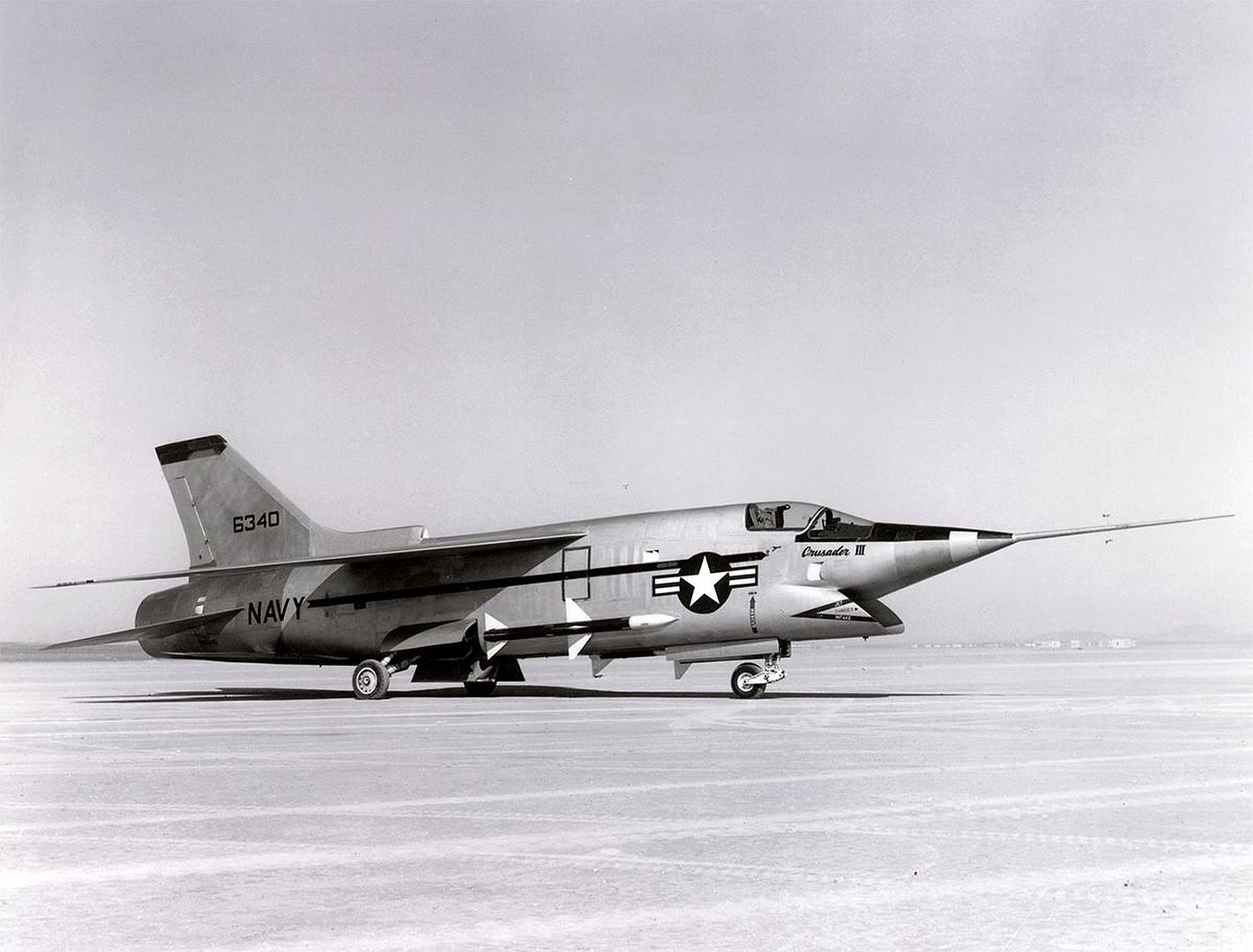
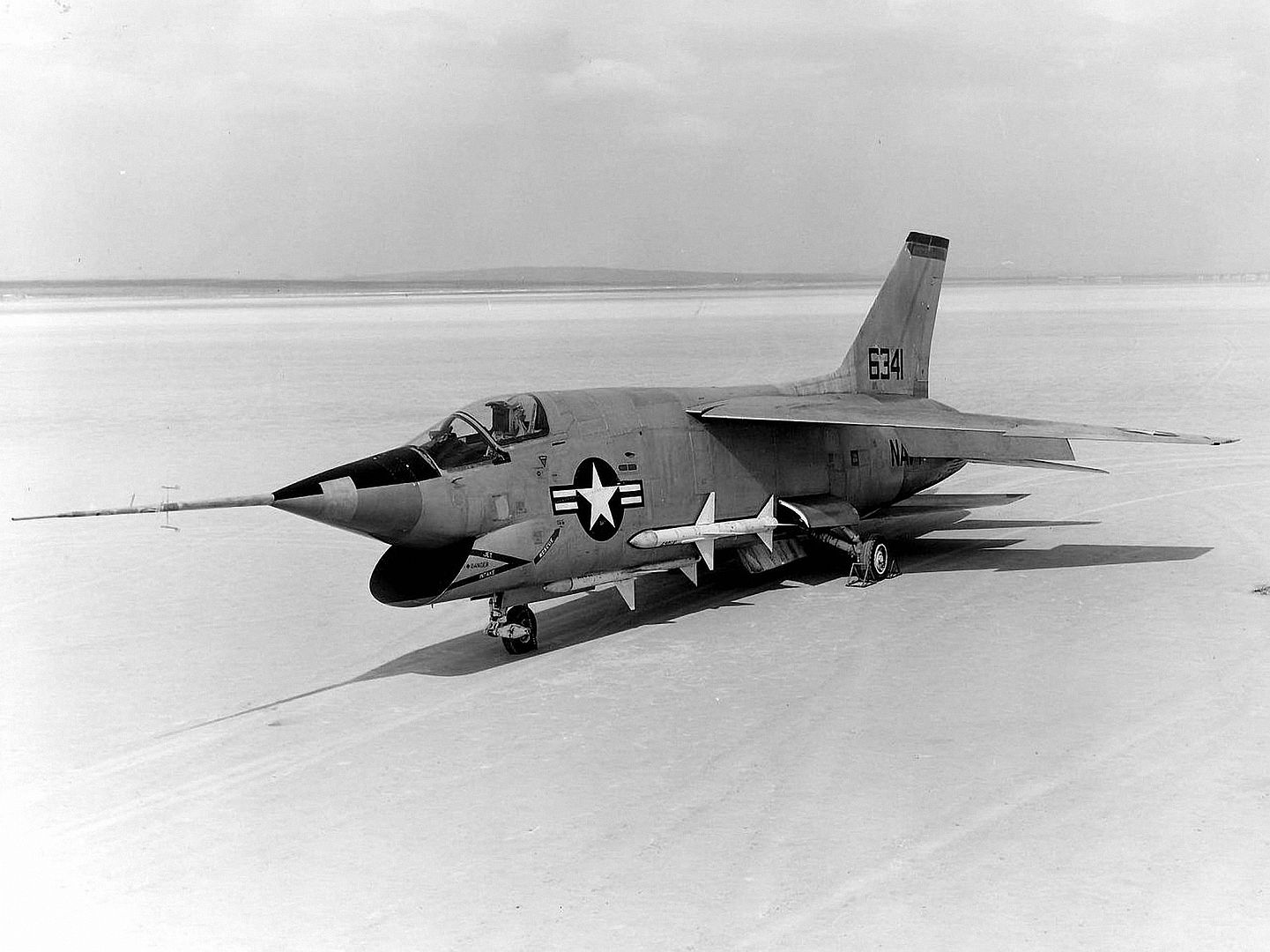
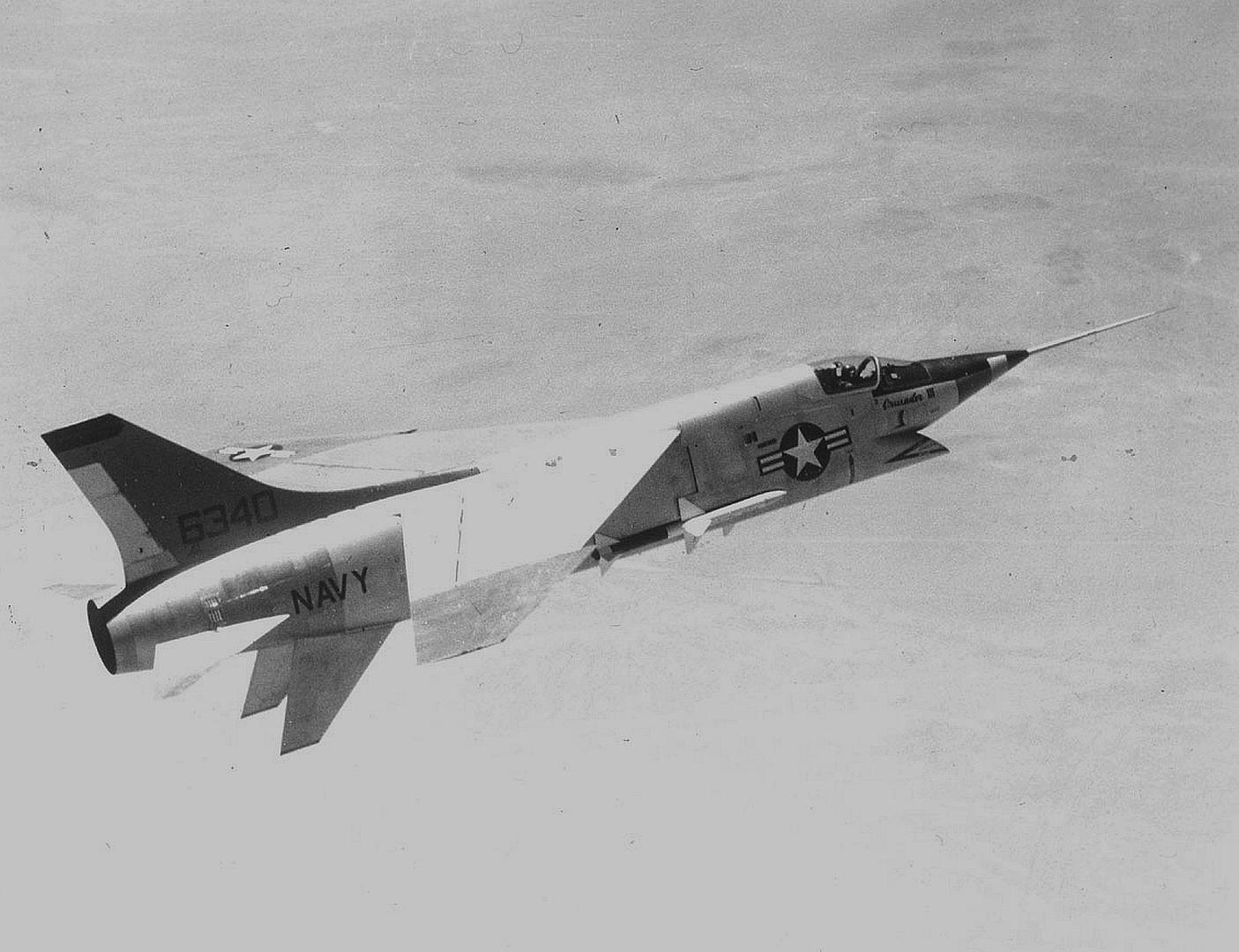
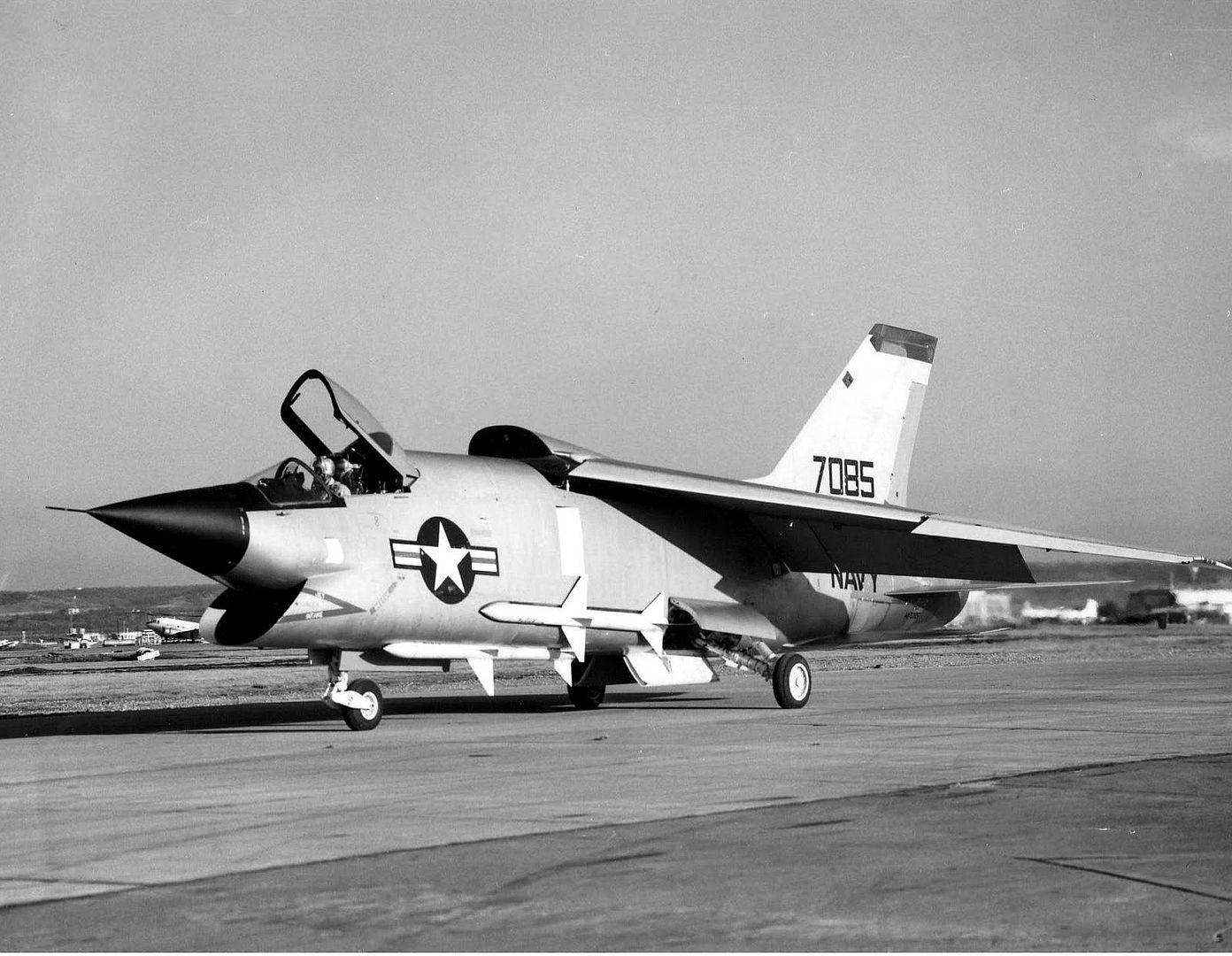



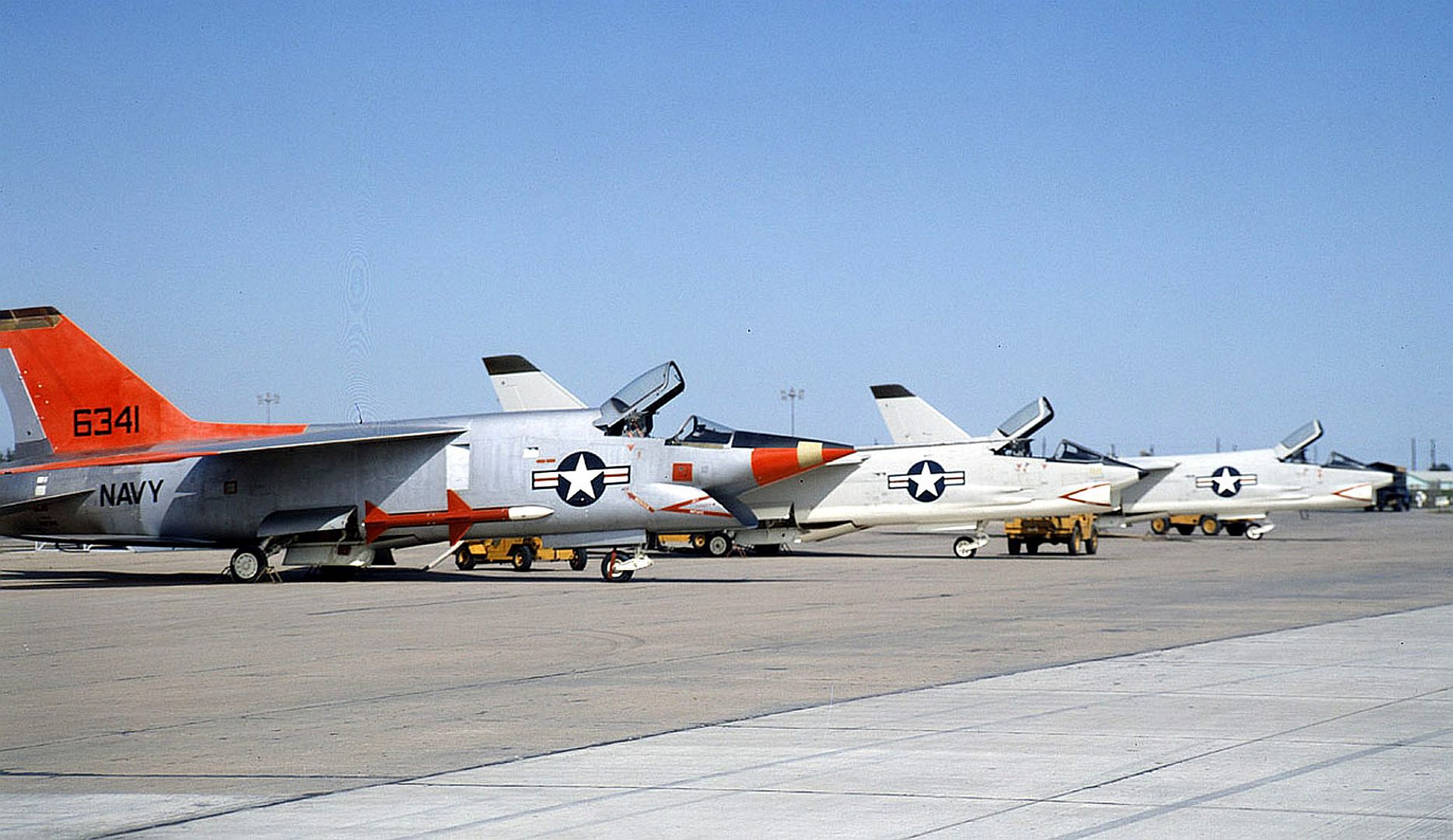
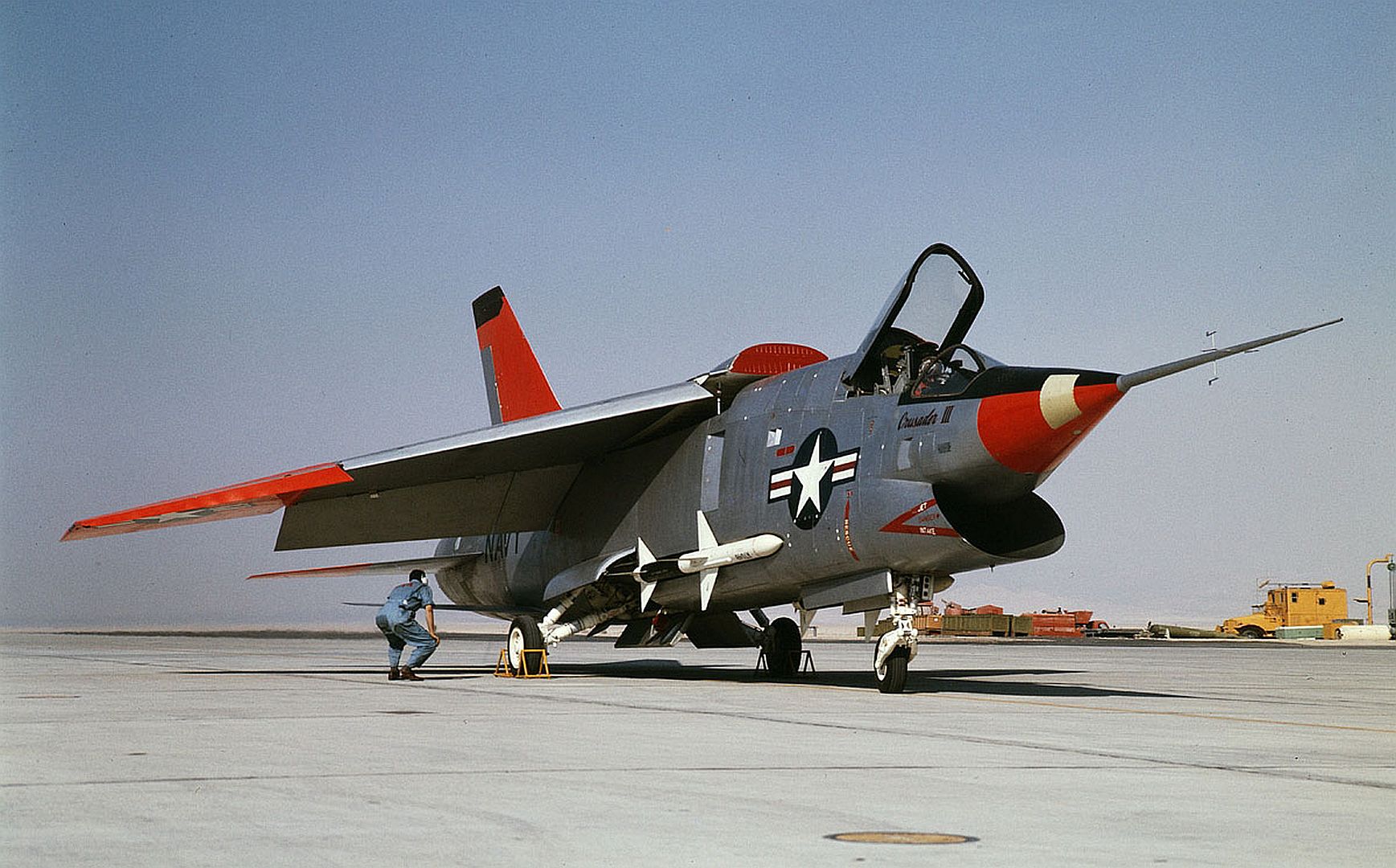
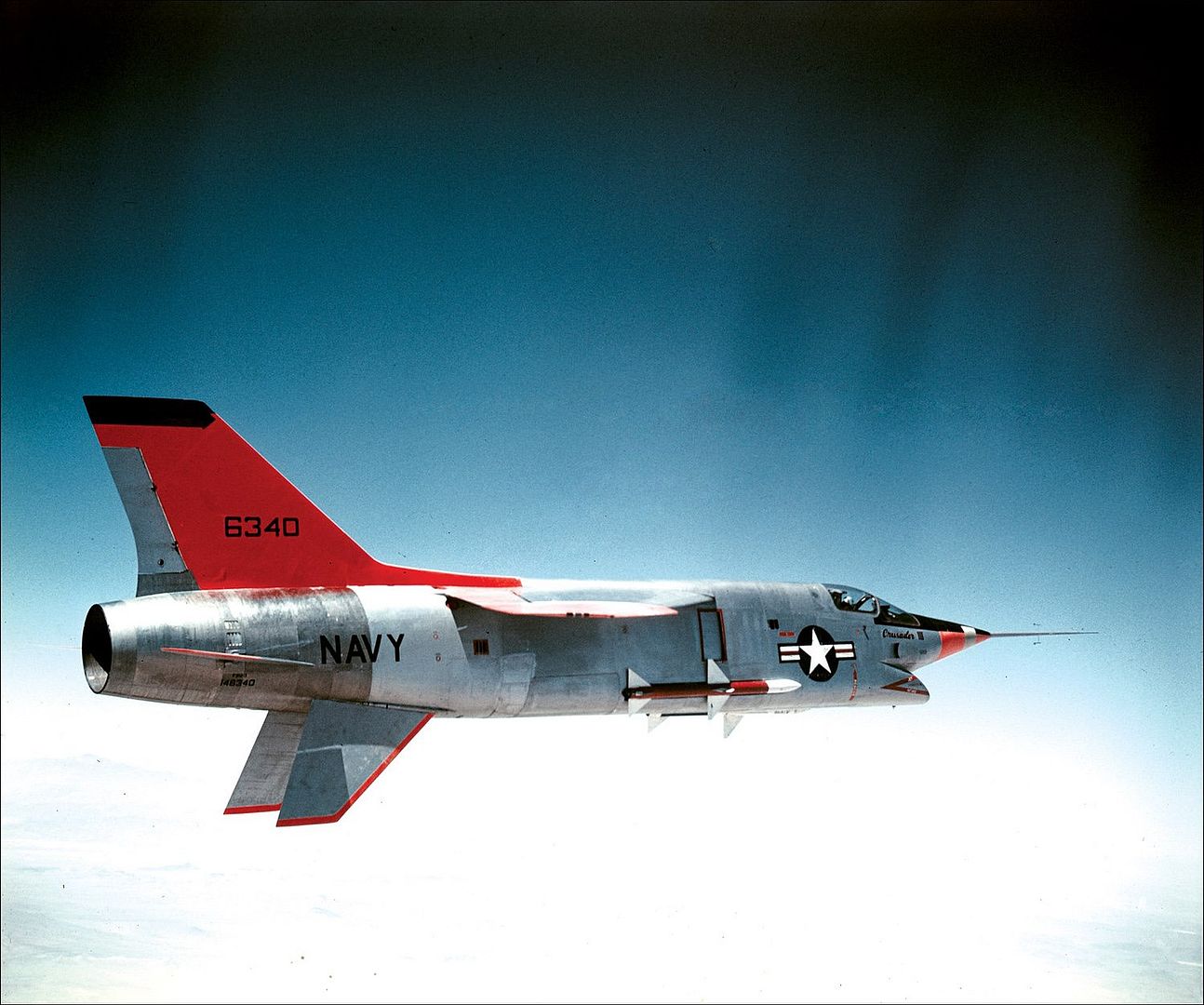
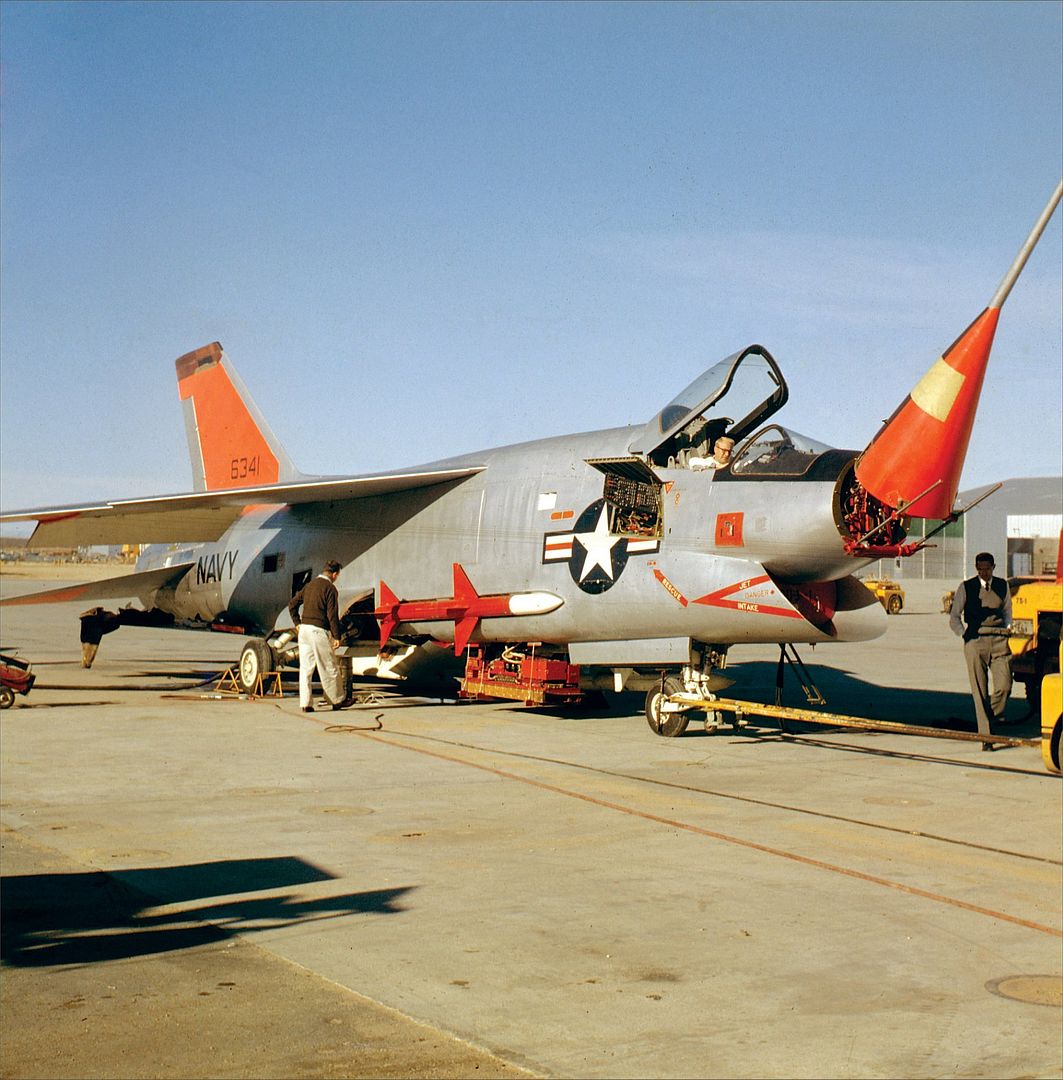
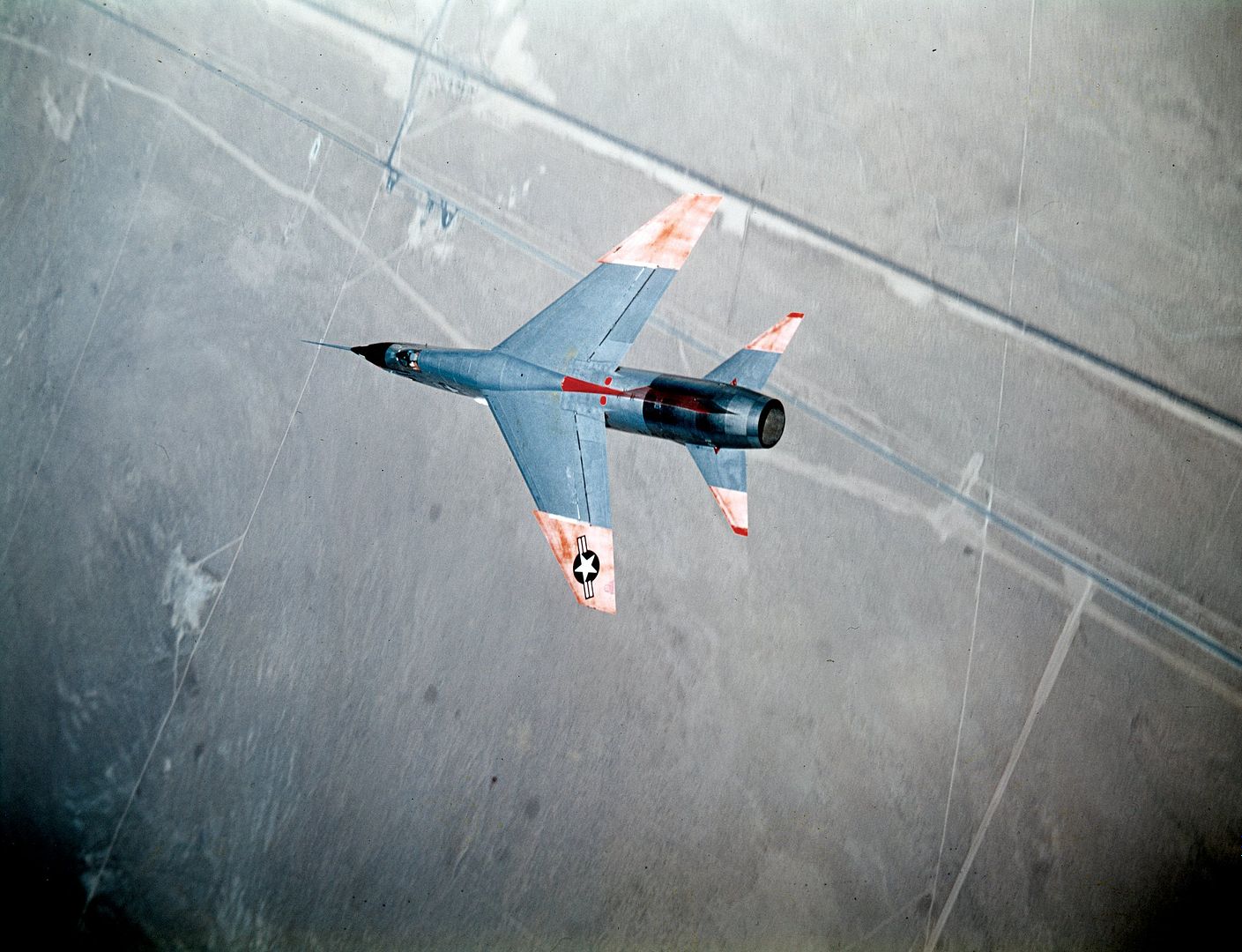
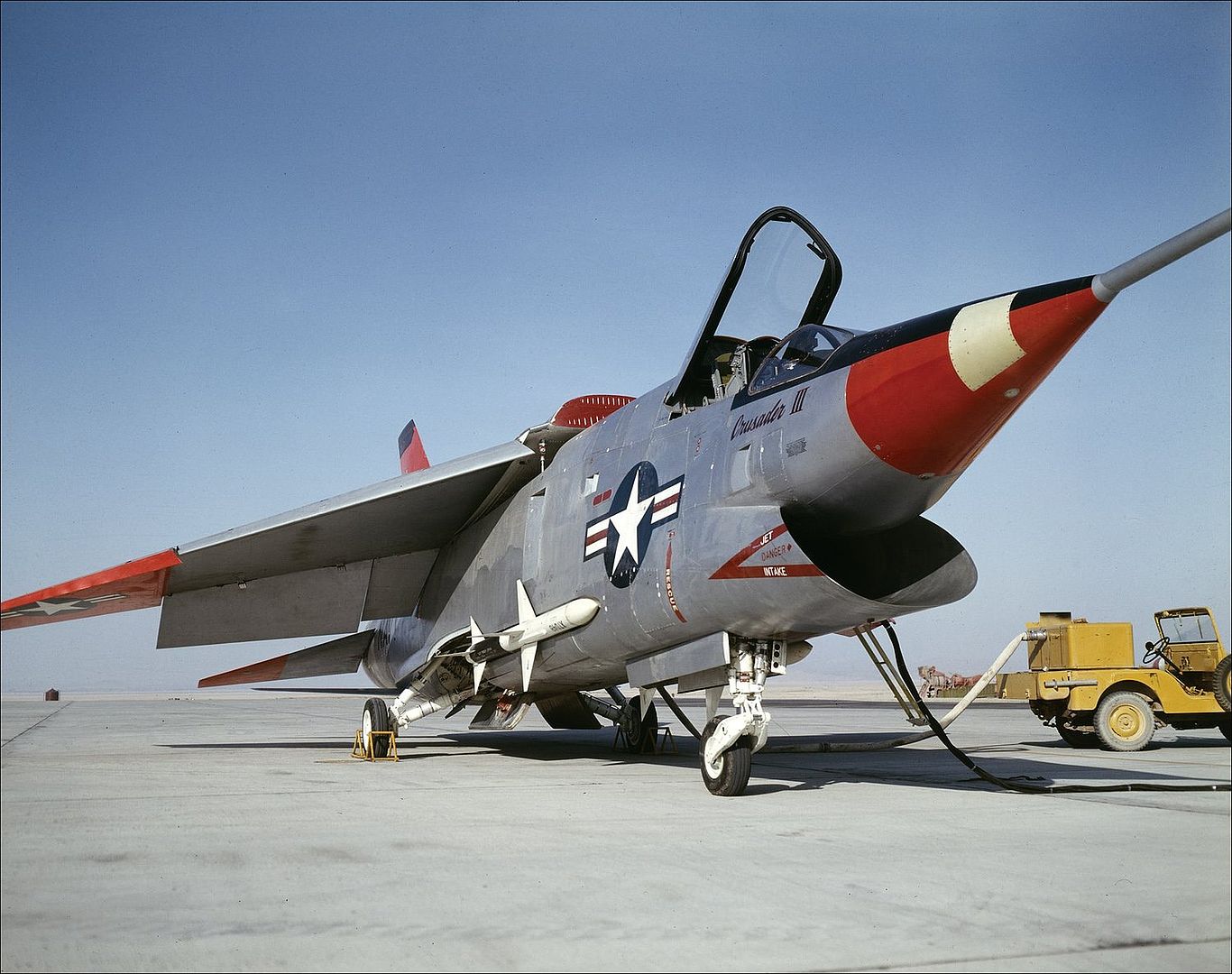
Serials of the XF8U-3:
146340, 146341, 147085/147087
Specification of Vought XF8U-3 Crusader III:
Engine: One Pratt & Whitney J75-P-5A/6 turbojet, 16,500 lb.s.t. dry, 29,500 lb.s.t. with afterburning. Performance: Maximum speed 1457 mph (Mach 2.21) at 50,000 feet, 800 mph (Mach 1.05) at sea level. Crising speed 575 mph. Stalling speed 154 mph. Initial climb rate 32,500 feet. Combat ceiling 51,500 feet, service ceiling 60,000 feet. Combat range 645 miles. Maximum range 2044 miles. Maximum fuel 2036 US gallons. Weights: 21,862 pounds empty, 32,318 pounds combat, 37,856 pounds gross, 38,772 pounds maximum takeoff. Dimensions: wingspan 38 feet 11 inches, length 58 feet 8 inches, height 16 feet 4 inches, wing area 450 square feet. Projected armament was to have been three AIM-7 Sparrow air-to-air missiles. carried in slots cut into each lower side of the fuselage and on the fuselage belly just behind the forward landing gear. In addition, four AIM-9 Sidewinder missiles could also be carried.
Post a reply
- Go to Previous topic
- Go to Next topic
- Go to Welcome
- Go to Introduce Yourself
- Go to General Discussion
- Go to Screenshots, Images and Videos
- Go to Off topic
- Go to Works in Progress
- Go to Skinning Tips / Tutorials
- Go to Skin Requests
- Go to IJAAF Library
- Go to Luftwaffe Library
- Go to RAF Library
- Go to USAAF / USN Library
- Go to Misc Library
- Go to The Ops Room
- Go to Made in Germany
- Go to Campaigns and Missions
- Go to Works in Progress
- Go to Juri's Air-Raid Shelter
- Go to Campaigns and Missions
- Go to Works in Progress
- Go to Skinpacks
- Go to External Projects Discussion
- Go to Books & Resources
